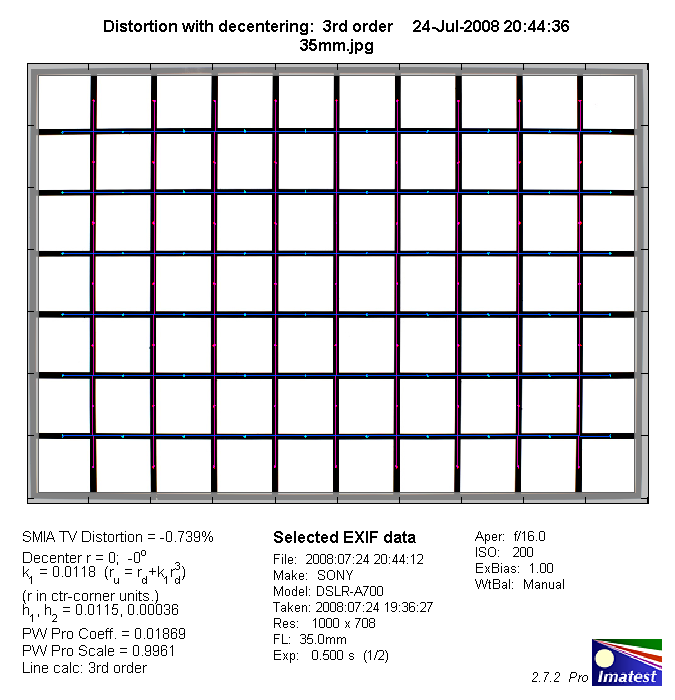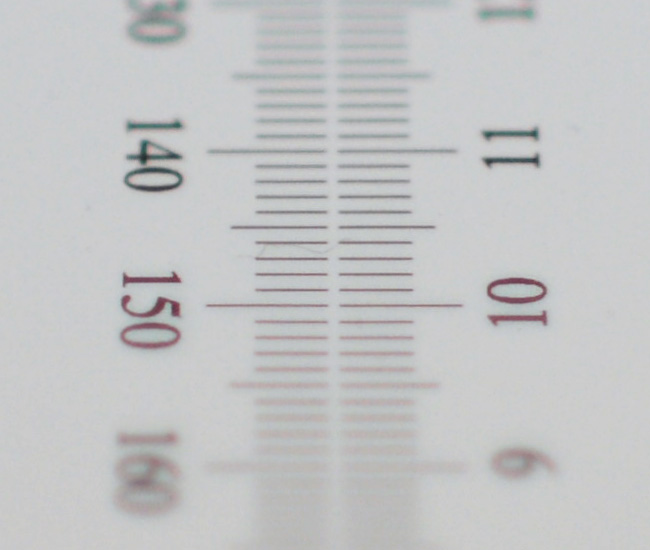|
Sony 35mm f/1.4 G ( SAL-35F14G ) - Review / Test Report - Analysis |
|
Lens Reviews -
Sony Alpha/NEX (APS-C)
|
|
Page 2 of 3

Distortion
The Sony 35mm f/1.4 produces only a slight degree (0.8%) of barrel distortion which is usually nothing
to worry about in field conditions.

The chart above has a real-world size of about 120x80cm.
Vignetting
The Sony 35mm f/1.4 is a full format lens thus enjoying the usual sweet spot advantage when used on an APS-C DSLR. At f/1.4 you may experience moderate vignetting (0.7EV) in critical situations but the problem is already negligible by f/2.

MTF (resolution)
The resolution characteristic of the Sony lens is rather disappointing at large aperture settings. At f/1.4 the center quality is already decent but there isn't really much resolution left at the image borders. The situation improves a bit at f/2 and the border resolution gets acceptable by f/2.8 but it really takes f/4 in order to achieve a very good quality across the frame. This is "too late" for a lens in this price class.
Please note that the MTF results are not directly comparable across the different systems!
Below is a simplified summary of the formal findings. The chart shows line widths per picture height (LW/PH) which can be taken as a measure for sharpness.
If you want to know more about the MTF50 figures you may check out the corresponding Imatest Explanations
Chromatic Aberrations (CAs)
Lateral chromatic aberrations (color shadows at harsh contrast transitions) are quite poor with an average pixel width beyond 2.5px at the image borders. This is another characteristic where the rather old design takes its toll.

Here's a sample crop (100%) taken at the image borders @ f/8:

Lateral CAs can be corrected via imaging tools such as Adobe Photoshop so it's not a real show-stopper if you're willing to invest time in post-processing.
Longitudinal Chromatic Aberrations (LoCA)
Just like most ultra-large aperture lenses the Sony 35mm f/1.4 has its share of LoCAs (non-coinciding focal planes of the various colors), sometimes called "bokeh CAs". As you can notice below the halos have different colors - magenta (red + blue) in front the focus point and green beyond. The problem is rather hefty at f/1.4. It decrease slowly the further you stop down but it is still present at f/2.8.
|
Move the mouse cursor over the f-stop marks below to observe the respective LoCAs
|
| f/1.4 |
f/2 |
f/2.8 |
|

|
Bokeh (out-of-focus blur)
The Sony 35mm f/1.4G is able to produce a very shallow depth-of-field thanks to its ultra-large aperture so the quality of the the background and foreground blur (bokeh) is a major aspect. The lens has a bit of a problem here - probably introduced by the aspherical element. The bokeh can look somewhat nervous in "busy" scenes. Here's an example:
 Naturally it is possible to achieve a good bokeh if you can keep a significant distance between your main object and the surrounding environment but that's a fairly easy task for most ultra-large aperture lenses anyway.
Naturally it is possible to achieve a good bokeh if you can keep a significant distance between your main object and the surrounding environment but that's a fairly easy task for most ultra-large aperture lenses anyway.
|